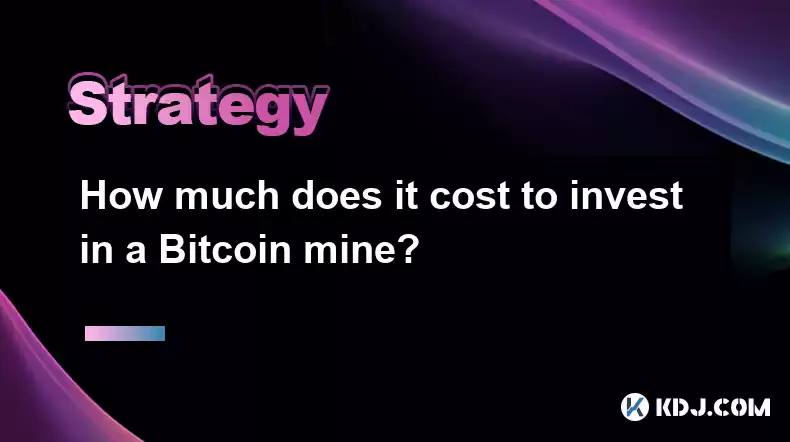-
 bitcoin
bitcoin $122659.385674 USD
0.52% -
 ethereum
ethereum $4484.113342 USD
-0.09% -
 bnb
bnb $1304.229256 USD
-0.85% -
 tether
tether $1.000204 USD
-0.03% -
 xrp
xrp $2.860636 USD
-0.51% -
 solana
solana $227.288799 USD
2.36% -
 usd-coin
usd-coin $0.999805 USD
0.01% -
 dogecoin
dogecoin $0.252837 USD
1.18% -
 tron
tron $0.341149 USD
1.12% -
 cardano
cardano $0.830507 USD
0.33% -
 hyperliquid
hyperliquid $45.792319 USD
0.04% -
 chainlink
chainlink $22.422164 USD
1.55% -
 ethena-usde
ethena-usde $1.000283 USD
0.01% -
 sui
sui $3.511389 USD
0.83% -
 stellar
stellar $0.385276 USD
-0.44%
How much does it cost to invest in a Bitcoin mine?
Investing in a Bitcoin mine entails initial costs for hardware, electricity, ventilation, and security, while operating costs include ongoing expenses for electricity, repairs, and potential pool fees.
Jan 08, 2025 at 02:20 am

- Initial Costs: Hardware, electricity, ventilation, security
- Operating Costs: Electricity, repairs, maintenance
- Location Considerations: Climate, energy availability
- Profitability Analysis: Hashrate, coin price, difficulty
- Risk Management: Volatility, hardware failure
- Hardware: Mining rigs consist of specialized computers equipped with high-powered GPUs or ASICs. These rigs can cost anywhere from $1,000 to $10,000 each.
- Electricity: Bitcoin mining consumes significant amounts of electricity, so a reliable and affordable power source is crucial. Costs vary based on location and electricity rates.
- Ventilation: Mining rigs generate a lot of heat, requiring adequate ventilation to prevent overheating and damage. This may include fans, air conditioning systems, or even specialized cooling rigs.
- Security: Securing your mining operation is essential to prevent theft or sabotage. Consider physical security measures, such as access control and alarms, as well as cybersecurity measures to protect against malware.
- Electricity: Electricity remains the largest operating expense for Bitcoin mining. The cost depends on both the electricity consumption of your mining rigs and the local electricity rates.
- Repairs and Maintenance: Over time, mining rigs require repairs and maintenance. This includes component replacements, software updates, and general care to ensure optimal performance.
- Pool Fees: Many miners join mining pools to increase their chances of finding a block. These pools typically charge a small fee for their services, which adds to operating costs.
- Climate: Ideal locations for Bitcoin mining offer cool and dry climates to minimize heat dissipation and cooling costs. Extreme heat or humidity can reduce mining efficiency and increase maintenance requirements.
- Energy Availability: Proximity to reliable and affordable energy sources is crucial. Consider locations with dedicated power plants, low electricity costs, or access to renewable energy sources.
- Hashrate: The hashrate of a mining rig measures its computational power. Higher hashrates increase the chances of finding a block and collecting rewards.
- Coin Price: The profitability of Bitcoin mining depends on the current price of Bitcoin. When the price is high, mining rewards are more valuable.
- Difficulty: The difficulty of Bitcoin mining constantly adjusts to maintain a target block discovery time. As more miners join the network, the difficulty increases, reducing individual miners' chances of finding a block.
- Volatility: Bitcoin prices are highly volatile, which can affect the profitability of mining. Drops in value can lead to financial losses.
- Hardware Failure: Mining hardware can fail unexpectedly, causing downtime and lost profits. Proper maintenance and backup equipment can mitigate this risk.
Q: What is the minimum investment required to start a Bitcoin mine?A: The minimum investment depends on the scale of operation, but it typically starts around $10,000 to $20,000.
Q: How much profit can I make from Bitcoin mining?A: Profitability depends on factors such as hashrate, coin price, and operating costs. It is advisable to conduct thorough research and consider risk factors before investing.
Q: Is Bitcoin mining still profitable in 2023?A: Mining profitability fluctuates with market conditions. While some miners still experience profits, the competitive landscape has become more challenging.
Disclaimer:info@kdj.com
The information provided is not trading advice. kdj.com does not assume any responsibility for any investments made based on the information provided in this article. Cryptocurrencies are highly volatile and it is highly recommended that you invest with caution after thorough research!
If you believe that the content used on this website infringes your copyright, please contact us immediately (info@kdj.com) and we will delete it promptly.
- Solana, Hyperliquid, and Market Consolidation: A Whale's-Eye View
- 2025-10-09 16:25:13
- Jupiter, Ethena Labs, and JupUSD: A New Era for Solana DeFi
- 2025-10-09 17:05:12
- Wallets, MemeRush, and Binance: A Wild Ride in the Crypto World!
- 2025-10-09 16:45:15
- IPO Guide: Navigating the Initial Public Offering Like a Pro
- 2025-10-09 17:05:12
- Polygon Rio: Blazing to 5000 TPS and Beyond!
- 2025-10-09 16:25:13
- Canary's TRUMP Coin ETF: From DTCC Listing to Potential Wall Street Darling?
- 2025-10-09 16:45:15
Related knowledge

Practical parameter settings for a Bitcoin multi-timeframe moving average system
Sep 18,2025 at 10:54pm
Optimizing Timeframe Combinations for Bitcoin Trading1. Selecting appropriate timeframes is crucial when building a multi-timeframe moving average sys...

How can I filter out false breakouts in Dogecoin high-frequency trading?
Sep 22,2025 at 01:00am
Understanding False Breakouts in Dogecoin Trading1. A false breakout occurs when Dogecoin's price appears to move beyond a defined support or resistan...

Techniques for identifying tops and bottoms in the Bitcoin on-chain NVT model
Sep 20,2025 at 07:54pm
Understanding the NVT Model in Bitcoin Analysis1. The Network Value to Transactions (NVT) ratio is often described as the 'P/E ratio' of the cryptocur...

What does the surge in open interest in Bitcoincoin futures mean?
Sep 20,2025 at 11:18pm
Understanding the Surge in Dogecoin Futures Open Interest1. A surge in open interest within Dogecoin futures indicates a growing number of active cont...

How can I use the Ethereum USDT premium to gauge market sentiment?
Sep 18,2025 at 11:55pm
Understanding the Ethereum USDT Premium1. The Ethereum USDT premium refers to the price difference between USDT (Tether) traded on Ethereum-based plat...

What should I do if Ethereum staking yields decline?
Sep 20,2025 at 06:18am
Understanding the Causes Behind Declining Ethereum Staking Yields1. The Ethereum network transitioned to a proof-of-stake consensus mechanism with the...

Practical parameter settings for a Bitcoin multi-timeframe moving average system
Sep 18,2025 at 10:54pm
Optimizing Timeframe Combinations for Bitcoin Trading1. Selecting appropriate timeframes is crucial when building a multi-timeframe moving average sys...

How can I filter out false breakouts in Dogecoin high-frequency trading?
Sep 22,2025 at 01:00am
Understanding False Breakouts in Dogecoin Trading1. A false breakout occurs when Dogecoin's price appears to move beyond a defined support or resistan...

Techniques for identifying tops and bottoms in the Bitcoin on-chain NVT model
Sep 20,2025 at 07:54pm
Understanding the NVT Model in Bitcoin Analysis1. The Network Value to Transactions (NVT) ratio is often described as the 'P/E ratio' of the cryptocur...

What does the surge in open interest in Bitcoincoin futures mean?
Sep 20,2025 at 11:18pm
Understanding the Surge in Dogecoin Futures Open Interest1. A surge in open interest within Dogecoin futures indicates a growing number of active cont...

How can I use the Ethereum USDT premium to gauge market sentiment?
Sep 18,2025 at 11:55pm
Understanding the Ethereum USDT Premium1. The Ethereum USDT premium refers to the price difference between USDT (Tether) traded on Ethereum-based plat...

What should I do if Ethereum staking yields decline?
Sep 20,2025 at 06:18am
Understanding the Causes Behind Declining Ethereum Staking Yields1. The Ethereum network transitioned to a proof-of-stake consensus mechanism with the...
See all articles










































































